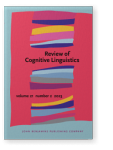Vol. 21:2 (2023) ► pp.486–514
Top-down and bottom-up approaches to teaching English verb-particle constructions
Construction-based and metaphor-based instruction
The present study examines two cognitive linguistics approaches to foreign language teaching. One draws on the conventionality of language use that a variety of expressions can be understood as instances of more general patterns, e.g., kick them out and eat it up as verb-object-particle, whereas the other centers on linguistic creativeness such as novel combinations or associations, e.g., chest down the ball. Noting that English verb-particle constructions (VPCs) exemplify both linguistic conventionality and creativeness, two types of instruction have been developed–namely, top-down instruction and bottom-up instruction. The top-down instruction presents VPCs as instances of conventional argument structures such as motion and resultative constructions (Goldberg, 2015), whereas the bottom-up instruction focuses on creative compositions of literal and metaphorical meanings (Lakoff & Johnson, 1980). The two types of instruction were provided for Korean EFL learners, and their knowledge of VPCs was measured by a pretest, an immediate posttest, and a four-week delayed posttest. Results of the immediate posttest showed that both types of instruction were effective in improving the learners’ knowledge of literal and figurative VPCs. In the delayed posttest, significantly greater retention was observed for the construction-based top-down instruction. This finding highlights the importance of argument structures as super-constructions in teaching VPCs to EFL learners.
Article outline
- 1.Introduction
- 2.Verb-Particle Constructions
- 2.1General descriptions
- 2.2Constructionist approaches
- 2.3Metaphor-based approaches
- 3.Method
- 3.1Participants
- 3.2Instruction
- 3.2.1Construction-based instruction
- 3.2.2Metaphor-based instruction
- 3.3Testing
- 3.4Analyses
- 4.Results
- 4.1Short-term effects
- 4.2Longer-term effects
- 5.Discussion
- 6.Conclusion
- Acknowledgement
- Notes
- The abbreviations are as follows
-
References
